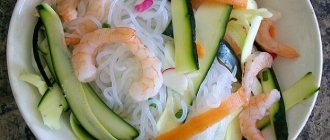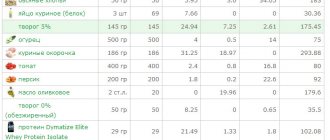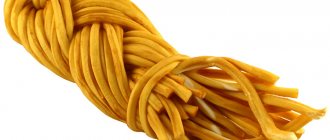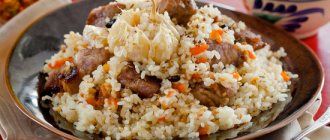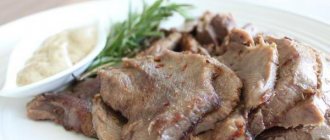Properties of egg noodles
Nutritional value and composition | Vitamins | Minerals
How much does egg noodles cost (average price for 1 pack)?
Moscow and Moscow region.
70 rub.
The noodle product belongs to a subspecies of pasta and is distinguished by its original appearance. Long and at the same time narrow strips of noodles are made from water and flour. Moreover, noodle flour can be of different types. The type of pasta depends on what flour the noodles are made from. Wheat, rice, buckwheat, and also egg noodles are poured. Egg noodles differ from other types by the presence of eggs or egg powder in the product.
Typically, egg noodles are made from wheat flour with the addition of eggs. Moreover, when making egg noodles, only the whites or yolks of chicken eggs can be used. The final color of the pasta depends on this. Egg yolk noodles are distinguished by their rich yellow color; the broth made from such egg yolks is transparent. There are several options for preparing egg noodles. Often the dough for egg noodles is kneaded without water, just eggs and flour.
This product has improved taste and consumer qualities. Although, any homemade egg noodles will be very different from a mass-produced product. There is a not entirely correct, even biased opinion about noodles as a pasta product in modern consumer society. It is believed that egg noodles are a second-rate pasta product that does not bring benefits, but rather harms the human body. We hasten to refute unfair speculation and reviews.
We think the root of such reasoning lies in the instant egg noodles that have flooded the shelves of domestic grocery stores. However, there is a huge difference between instant noodles in packages or plastic cups and real egg noodles. Egg noodles are truly distinguished by their ease and quick preparation. And here it’s not at all a matter of the content of food additives, dyes and preservatives, which is what distinguishes modern instant noodles from a regular product.
The method of producing egg noodles gives the product exceptional consumer qualities and characteristics. As a result of scientific research, it has been proven that egg noodles contain more useful substances and minerals in their composition in comparison with wheat type of pasta. The calorie content of egg noodles is at a fairly high level and amounts to 304 Kcal per 100 grams of product. Noodles are added to soups, served as a side dish or main dish with a variety of sauces, seasonings and spices.
However, such an indicator of the calorie content of egg noodles cannot serve as evidence of the harmful effects of the product on the human body. It's all about the easy digestibility of egg noodles. The product perfectly saturates the body with beneficial vitamins and minerals, and the carbohydrates contained in egg noodles provide a boost of energy. Egg noodles can be an excellent product for a healthy and balanced diet, provided that you consume the product in moderation.
Egg noodles: recipes, how to cook, calories, benefits, harm
Noodles are a type of pasta. It looks like long narrow strips of dough, made from flour (wheat or rice) and kneaded with water. Egg noodles differ from other types in composition - they contain eggs or egg powder.
The origin of the word "noodle" still baffles scientists. According to Vasmer's etymological dictionary, the term originated from the Turkic language. The historical and etymological dictionary of P. Chernykh states that “noodles” originates from the verb “to lap.”
Noodles belong to the Asian culinary tradition. Chinese noodles are considered the oldest in the world (the first mentions date back to the second millennium BC).
The product can be prepared using various technologies. In everyday life, the product is rolled out into a thin layer, after which the dough is cut into narrow strips. On an industrial scale, this happens with the help of special automated knives and surfaces. In the culinary arsenal there are even special meat grinders that scroll the dough, squeezing out perfectly thin and even strips of noodles.
https://youtu.be/8kU8ML-NeGk
The product is prepared by cooking in boiling water without/with seasonings or in various broths. Most often the dish is combined with sauces and vegetables/meat/fish. The set of accompanying ingredients depends on the specifics of the restaurant, the cuisine used and the personal preferences of the consumer.
Cooking rice vermicelli
Rice flour vermicelli is often found in Asian cuisine: it is added to salads, first and second courses, and eaten as a side dish. It is healthier and lower in calories than noodles made from wheat flour, so it is suitable for those who are watching their figure. There are two cooking methods, the first is more suitable for cold dishes, and the second for soups.
- place the dry product in a cup;
- fill it with boiling water;
- leave to steam for a while (about five minutes);
- check readiness, then drain excess liquid;
- rinse with cold water;
- use for preparing Asian salads and main courses.
- boil the liquid on the stove;
- add salt, add rice noodles;
- cook in boiling salted water for four minutes;
- drain excess liquid, rinse thoroughly;
- Place in cups, add remaining ingredients and fill with broth.
What you need to know about egg noodles
The appearance of Asian noodles is slightly different from other pasta products. The first thing that catches your eye is its miniature size - flattened, flat strips, the width of which is 1 millimeter.
It may seem that such jewelry work requires a special dough, but the basis for the noodles are the simplest ingredients possible - water, eggs or egg powder, salt and flour (wheat is most often used for a balanced taste and high nutritional value).
To prepare the product, you can use either whole eggs or the white or yolk separately. The color of the finished product directly depends on the eggs. Noodles made from yolks will be a rich yellow color, while noodles made from whites will look grayish or half-transparent.
Regardless of the color and content of yolks/whites, the liquid in which the Asian delicacy is cooked always remains crystal clear.
There are whole special schemes for preparing egg noodles. Some of them exclude the use of liquid - only eggs, flour and spices are used for shaping. Such noodles are especially valuable in terms of taste and energy value.
Can egg noodles be considered a healthy food?
It all depends on the degree of processing of the product and its components. If the flour was made only from high-quality flour (coarse/durum wheat), eggs and filtered water, then the noodles are perfect as a healthy side dish.
If premium flour, thickeners, starch, various preservatives and flavor enhancers were used in the preparation, then the product becomes gastronomic garbage. How to find out? Read the composition. Remember the main rule - the shorter/clearer the composition, the better and healthier the product.
Correctly enter the product into your KBJU, and you can enjoy your favorite dish at least every day.
To be absolutely sure of the quality and benefits of the dish, prepare it yourself. This way you can control all the cooking processes and create unique noodles with a touch of personality.
There is no need to experiment with flour or egg powder. Spices are a real field for gastronomic searches.
Eliminate regular table salt from the recipe and add the abundance of spices that seems most beneficial to you.
Don’t forget to properly combine noodles with vegetables and meat/fish side dishes to properly saturate your body until your next meal.
Chemical composition of the ingredient
Nutritional value of dry egg noodles (per 100 grams)
| Calorie content | 384 kcal |
| Squirrels | 14.16 g |
| Fats | 4.44 g |
| Carbohydrates | 67.97 g |
| Alcohol | 0 g |
| Cholesterol | 84 mg |
| Ash | 1.12 g |
| Water | 9.01 g |
Vitamin composition of dry egg noodles (in milligrams per 100 grams)
| Retinol (A) | 0,017 |
| Beta-Carotene (A) | 0,002 |
| Calciferol (D) | 0,3 |
| Tocopherol (E) | 0,37 |
| Phylloquinone (K) | 0,0005 |
| Thiamine (B1) | 1,13 |
| Riboflavin (B2) | 0,43 |
| Choline (B4) | 78,7 |
| Pantothenic acid (B5) | 0,91 |
| Pyridoxine (B6) | 0,22 |
| Folic acid (B9) | 0,23 |
| Cobalamin (B12) | 0,00029 |
| Nicotinic acid (PP) | 10,6 |
Nutrient composition of dry egg noodles (in milligrams per 100 grams
| Macronutrients | |
| Potassium (K) | 244 |
| Calcium (Ca) | 35 |
| Magnesium (Mg) | 58 |
| Sodium (Na) | 21 |
| Phosphorus (P) | 241 |
| Microelements | |
| Iron (Fe) | 4,01 |
| Manganese (Mn) | 0,86 |
| Copper (Cu) | 0,3 |
| Selenium (Se) | 0,078 |
| Zinc (Zn) | 1,92 |
Recipe for egg noodles with green vegetables
We will need:
- egg noodles – 80 g;
- garlic – 2 cloves;
- chili pepper – 2 pcs;
- zucchini – 2 pcs;
- asparagus (pre-blanched in boiling water) – 2 pcs;
- fresh green peas – 50 g;
- fresh spinach – 100 g;
- olive oil – 1 teaspoon;
- coconut milk – 100 ml;
- salt/pepper/favorite spices to taste.
Preparation
Cook pasta until al dente (cook 1 minute less than cooking instructions). Heat a frying pan, add olive oil, fry the garlic and chili pepper.
Once the vegetables are soft and golden brown, add the chopped zucchini, green peas and asparagus (previously blanched) into the pan. Fry the vegetable mixture until cooked.
There is no need to use spices at this stage - they will be needed in the final part of cooking.
Once the vegetables are ready, pour the coconut milk into the pan and bring the mixture to a boil. Add egg noodles to boiling coconut-vegetable broth. Reduce heat and heat the dish until the noodles are completely cooked. Add your favorite spices, taste the dish periodically and adjust the flavor palette.
Video: “Homemade Egg Noodles”
Our grandmothers hardly looked at the notebook when preparing this dish. My grandmother kneaded the dough effortlessly, adjusting the amount of ingredients along the way. She shared the secret with me, and I shared it with you.
Properly prepared homemade noodles do not become mushy; they are tender and moderately elastic. To ensure it turns out like this, never add water when kneading.
If there is not enough moisture, add an egg (or one yolk, if you are making the dough with yolks), but not water. Otherwise, the paste will be loose and it is possible that it will boil over.
Dried egg noodles made according to this recipe can be stored for up to 2 months, so you can safely knead double the amount and stock up for future use.
Ingredients:
- Chicken egg – 3 pieces;
- Flour – 300 g;
- Vegetable oil – 1 tsp.
On a note
The amount of ingredients is calculated based on the fact that for every 100 g of flour, 1 egg is taken.
Preparation:
- Sift the flour and beat the eggs into the well in the center and add the oil.
- Mix the dough. It turns out dense and tight.
- Place in a bag, cover with a bowl or cover with cling film, and leave for at least half an hour.
- Divide the bun in half and roll out each part separately. The rolling thickness does not exceed 1 mm.
- Let the dough dry a little so that it does not stick to the knife.
- We proceed further depending on what kind of cutting we need. If it is long, then we roll the sheet into a tube; if it is short, we fold it in four, cut it into strips 3-5 cm wide, collect them in a stack and cut strips of the required width.
- Lay out to dry.
This is a basic (classic) homemade noodle dough made with eggs without water. If you are making a portion for soup and are not going to store the homemade semi-finished flour product for a long time, you can add salt; for long-term storage, this is not necessary.
If there is no time to dry, this can be quickly done in a dry frying pan over low heat. Make sure that drying does not turn into frying.
Homemade noodles
Most people do not know what the term calorie content of staple foods means, and this is bad, since this is the most valuable value, because our health depends on it. That is why in this article we will try to consider this modern concept in detail.
Calories are used to estimate the energy content of food products. Having information about the calorie content of several products, there is a chance to accurately calculate the calorie component of the dish that you want to prepare personally.
But, as a rule, having information only about the number of calories “hidden” in products, that is, knowing the calorie content of products 100%, is completely insufficient; in addition to the calorie content of our menu, you certainly need to take into account their biochemical composition, this is: the amount of fat, polypeptides and saccharides, as well as the presence of liquid and other useful substances. In addition, you must always take into account how many kilocalories you burn during the working day. The number of kilocalories that a person can expend during the day directly depends on daily activity, the type of work you do (physically active or sedentary) and the biological age of the person.
A girl's body basically loses a couple thousand calories every day. Then, in order to increase the burning of energy obtained from food, you need to exercise as often as possible and develop an active lifestyle - rollerblading, cycling, doing pull-ups, going to tennis, fitness, dancing.
Standard carbohydrates, which we eat with buns, sweets, pastries, and cakes, are immediately broken down before reaching the esophagus. The remaining undigested saccharides will be deposited in the body's cells as excess fat.
Not many people know that proteins and fats are used for tissue regeneration and renewal. To provide the body with the required chemicals, every day you need to consume at least four hundred grams of carbohydrates, eighty grams of polypeptide and one hundred grams of triglyceride. The body receives these microelements we need from food products, so it is advisable to accurately study their biochemical composition.
The important information is that different types of nutrients are involved in the body's metabolism at different rates and naturally awaken different feelings of satiety in people. For example, the body prefers to spend saccharides, elements with a quickly extracted energy component, mainly for current energy needs. The potential for storing saccharides in the form of glucose, or for converting saccharides into triglycerides, is very limited. Therefore, carbohydrates, even with a very small amount in food, give us a feeling of fullness, causing people to stop eating.
Squirrels behave the same way. The body does not form their reserves. All processed polypeptides are sent either to replace polypeptide molecules in tissues, or to a lesser extent for physical needs. We can’t eat a lot of proteins - we have nowhere to put them. Therefore, protein foods are also quite filling.
